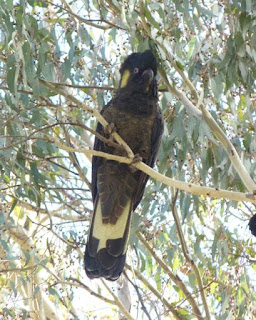There has been a build up in numbers of the Yellow-tailed Black-cockatoo (hereafter YTBC) in recent months so I thought a review article was called for. Specific recent sightings have included
- 34 overflying Whiskers Creek; and
- 60 descending on Banksias in a garden on Widgiewa Rd
My Early History with YTBC
In the 1970s I orienteered in South Australia and when the course involved pine trees it was quite common to hear YTBC in the canopy and to hear the thuds of the pine cones they were feeding on hitting the ground. (Since the cones weighed about a kilogram and the trees were about 30m high it would have been ugly if the cones had hit a person!)
Early Canberra Commentary
When we arrived in the Canberra area (1983) the species was quite uncommon in the city and people used to go to the Cotter Pub and see the flock which roosted in pines there. This was in the foothills of the Brindabella ranges where there were extensive pine plantations
Early Canberra Commentary
When we arrived in the Canberra area (1983) the species was quite uncommon in the city and people used to go to the Cotter Pub and see the flock which roosted in pines there. This was in the foothills of the Brindabella ranges where there were extensive pine plantations
Sometime in the 1980s we were involved in a study of the species and the organisers thereof noted that the YTBC is one of the (probably few) species to have benefited from the pine plantations infesting the landscape.
These comments are quite consistent with the words in the Canberra Birders 'Bible': "Birds of the ACT:two centuries of change" by Steve Wilson OAM:
The mini-peak in 2000-01 is hard to explain but may represent the birds moving around from the Greenhills pine plantation, burnt out in less extensive fires in December 2001.
The 'settling down' to a slightly higher abundance than pre-2003 possibly reflects the inclusion of a few extra-urban sites in the GBS since that time.
Since I started keeping records in 2007 YTBC have been recorded somewhere in the study area every month. They tend to be found most often munching in the pine windbreaks along driveways.
This group (10 birds in total - they wouldn't group for a photo of the whole flock) appeared to be in display mode.
Note the apparent paleness of the yellow tail panels against the bright sky. While there are White-tailed Back-cockatoos the closest ones are in SW Western Australia - some 3,000 km away! The other large Black-cockatoo in the area is the Glossy Black-cockatoo which has red panels in the tail (also a different call, and only feeds on Allocasurinas not pine trees). The YTBC do eat gum nuts as well:
These comments are quite consistent with the words in the Canberra Birders 'Bible': "Birds of the ACT:two centuries of change" by Steve Wilson OAM:
"(YTBC) are sometimes seen flying over urban areas, but most of the fairly frequent records have been from the damper mountains and the pine forests."In January 2003 the pine plantations in the Brindabellas were obliterated by bushfires. This led to the YTBC becoming itinerant flocks seeking food and shelter in the Urban area of the ACT as illustrated in this graph from the COG Garden Bird Survey.
The mini-peak in 2000-01 is hard to explain but may represent the birds moving around from the Greenhills pine plantation, burnt out in less extensive fires in December 2001.
The 'settling down' to a slightly higher abundance than pre-2003 possibly reflects the inclusion of a few extra-urban sites in the GBS since that time.
Since I started keeping records in 2007 YTBC have been recorded somewhere in the study area every month. They tend to be found most often munching in the pine windbreaks along driveways.
This group (10 birds in total - they wouldn't group for a photo of the whole flock) appeared to be in display mode.
Note the apparent paleness of the yellow tail panels against the bright sky. While there are White-tailed Back-cockatoos the closest ones are in SW Western Australia - some 3,000 km away! The other large Black-cockatoo in the area is the Glossy Black-cockatoo which has red panels in the tail (also a different call, and only feeds on Allocasurinas not pine trees). The YTBC do eat gum nuts as well:






No comments:
Post a Comment
I am very happy to receive constructive comments. However anything I deem offensive will not be published.